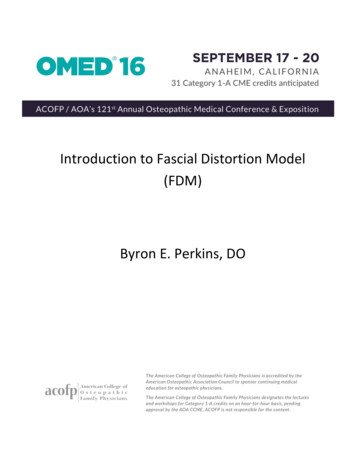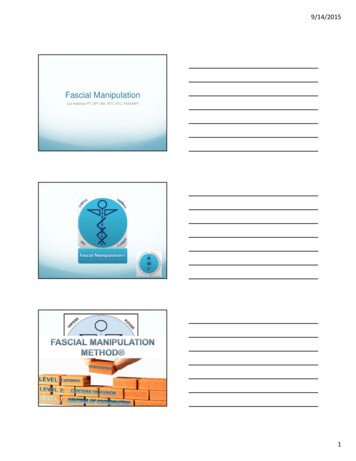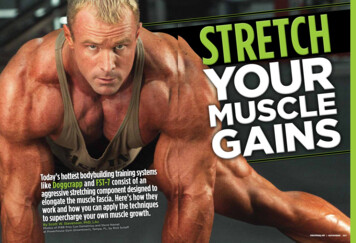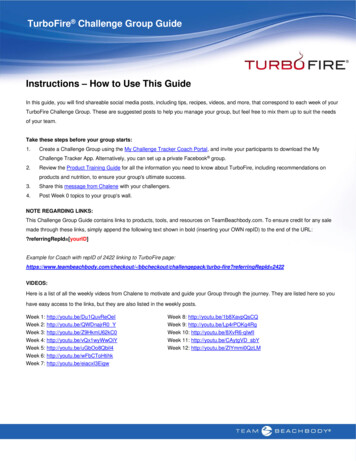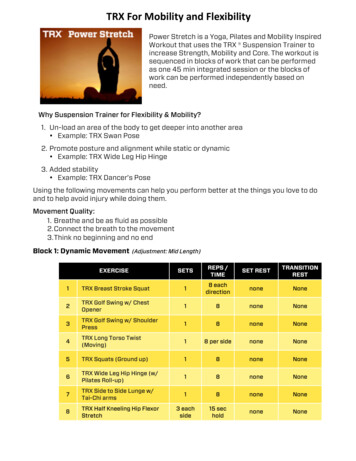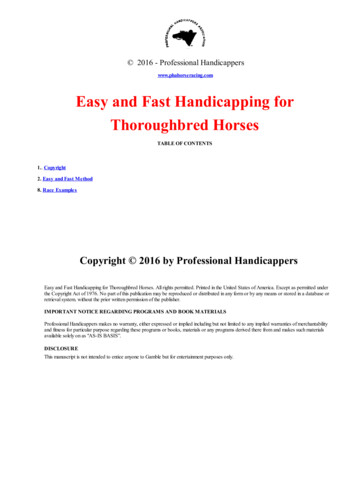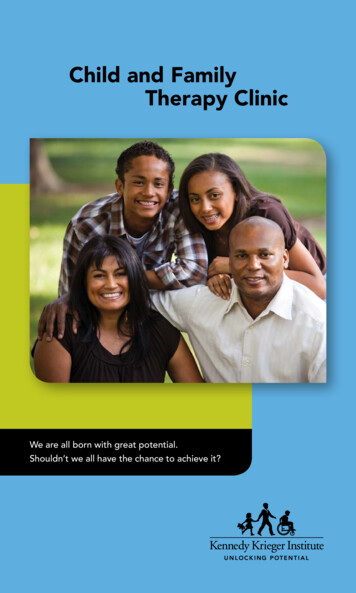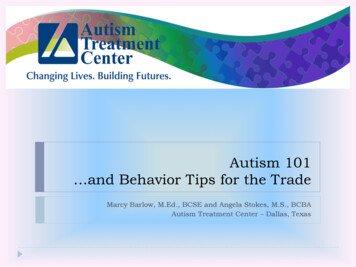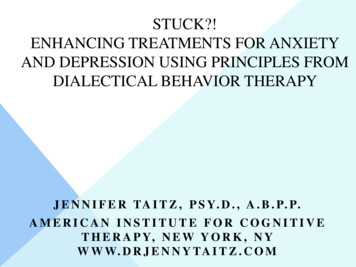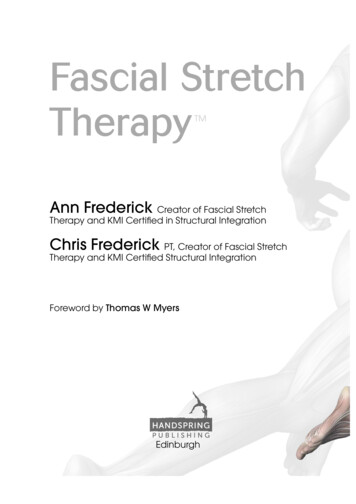
Transcription
Fascial StretchTherapy Ann Frederick Creator of Fascial StretchChris Frederick PT, Creator of Fascial StretchForeword by Thomas W Myers
ContentsHow Fascial Stretch Therapy came vixviiiSection 1Chapter 1 The Great Debate about StretchingIntroductionNegative outcomes in researchInjuriesStrength, power and speedPositive outcomes in researchStretching tissues and cellsGetting perspective on studies about stretching3FST model of assessment and 61717Chapter 2 Fascial Stretch Therapy Dissected21FlexibilityForm and functionTensegrityEvidence our cells are biotensegrity structuresFlexibility and stability of the prestressed bodyMyofascial tone and tensionCells do the twistStretching heals injured cellsIntroductionTen fundamental principles of FST1. Synchronize breathing with movementThe movementThe breathingCombining movement and breathing2. Tune nervous system to current needs3. Follow a logical order4. Range of motion gains without painMobilization and TOC5. Stretch neuromyofasciae, not just muscleMechanoreceptor location6. Use multiple planes of movement7. Target the entire joint8. Get maximal lengthening with traction21212222222323242526262727282910. Adjust stretching to current tions for FSTIndications for FSTPain conditionsStructural conditions with or without painSports32323333333335353535
viContentsSummaryReferencesChapter 3 Comparisons and ContrastsIntroductionCommon stretching methods and approachesProprioceptive Neuromuscular Facilitation (PNF)Fascial Stretch TherapyActive Isolated Stretching (AIS)Other contemporary stretching methods and techniquesAncient stretching techniquesManual therapy techniques that integrate stretchingSummaryReferencesChapter 4 Palpatory literacyMovement vs motion quandaryLet’s STARTAssessment techniques in a nutshellSITTT4546474748491. Posture testing2. Myofascial testing3. Joint testing4. Nerve testingMovement assessment summaryTable-based assessmentPassive movementTOC ce to passive movement (R1-R3)Resisted movement 656666Section 2Chapter 5 Lower Body TechniqueKey Concepts for TechniqueIntroductionThe ten fundamental principles of FSTPractical guide to implementing the Ten Principles1. Breathing2. Nervous system3. Order4. Gain without pain5. Neuromyofascia6. Multiple planes of movement7. Joint8. Traction9. PNF10. Current goals696969697070707171717171727273
ContentsRange of motion evaluationExplanation of resistance of the tissue feelBreathing techniquePNF techniqueFST-PNF sample sequenceTips for the therapist’s successBody mechanicsPersonal adaptationsPractical SectionA. General Assessment1. Major observations2. Hip clearance move3. Leg length check4. Double leg traction5. Single leg traction6. Check lateral movementB. Range of Motion Evaluation Warm-up and FST-PNFStretch - Bent leg single joint1. 6874.5.6.7. Traction across body8.posterior hip - SBL, SPL, FLthoracolumbar, QL, lumbosacral, hip rotators - SFL, SPL, DFL9899100104C. Range of Motion Evaluation, Warm-up and FST-PNF Stretch –Straight Leg and Multiple Joints1.2.DFL, SBL, SPL3.SBL, SPL, FL, DFL4.SBL, FL, SPL, DFL5.6.106107109111vii
viiiContents8.D. Range of Motion Evaluation, Warm-up and FST-PNF Stretch1.2.3.SPL, LL4.5.E. Lateral Line1.F. Repeat Entire Series on the Right Leg B through DG. Pelvic Stabilization and Sacral Set1. Abductor contractions2. Adductor contractions3. Sacral setSBL Lower LegChapter 6 Upper Body TechniqueA. General EvaluationSupine observationsB. Side LyingShoulder warm-up and assessmentC. Range of Motion Evaluation Warm-up and FST-PNF Stretch1. Traction arm up2. 01321351351351361361401401404.5.SFAL, SBAL, DBAL, DFAL, FL143FL, SFAL, DFAL, DBAL, SBAL1466.7.8.9.10.11.
Contents17. Setting the shoulderD. ROM Evaluation Warm-up and FST-PNF Stretch1.2.SBAL, DBAL, SBL, DFL3.SBL, SBAL, DBAL4.SBL, SBAL, DBAL5.6.DBAL, DFL7.161162163164165169DBAL, DFL170SBL, SBAL, DBAL175SBL, SBAL, DBAL11.12.E. Sitting Stretches1.2.1768.9.10.1793.4.5.6.7.F. Floor Stretches1.1892.G. Standing Stretch1.194Acronym GlossaryIndex196197ix
xiHow Fascial Stretch Therapy This book is the product of two individual journeys, meeting up andcollaborating.Ann’s storyWhen I was a young girl, I had a premonition that I was destined to createsomething that would unite art and science. I was unsure what it would beor when it would happen, but I knew it was my calling. I also knew it wouldchange the way people looked at the topic and that it would eventually spreadworldwide. When it occurred, the development of FST felt like a combination ofdivine guidance and pure necessity.FST has been a blessing beyond words. People may question why I would wantto teach a technique I had developed and lose the exclusivity of being the onlyperson to offer it. My response has always been that when we are given a giftit is our responsibility to give back. How could I not share something that hasbrought so much joy and hope to myself and so many others?From age of four until I was 40, I spent my life in a dance studio. I was bothdancing professionally and teaching from the young age of 14. Movement andthe wonder of the body have been a part of my daily life for a very long time.My other passion was the science of the human body. I took every course offeredon the subject in school and read as much as I could about it. In high school,I distinctly remember going home and learning all 206 bones in one evening.I spent many years training dancers in flexibility and not one was ever injuredon my watch. I attributed it to the focus in my classes on extensive flexibilitytraining to which I dedicated at least 30 minutes during the warm-upcomponent in each class. In the dance world, extreme flexibility along withstrength is a non-negotiable requirement.While teaching a group stretch class at a local gym, I had an epiphany. I lookedout over my class, which was filled to capacity, and realized that there was agreat need in people to become more flexible, indeed senior citizens made abig chunk of the class. This new awareness of the general population needingand, more importantly, wanting help with their flexibility was eye opening andvery exciting. My vision was becoming clearer once I enrolled at Arizona StateUniversity (ASU), getting my degree and studying academic dance with a focusin kinesiology.As life would have it, at the end of one of my first stretch classes, a guy cameup to me and said, “They need what you are doing here at the ASU athleticdepartment.”
xiiHow Fascial Stretch Therapy It was an opportunity to work with college athletes from 26 different sports.The journey of creating Fascial Stretch Therapy began in the summer of 1995in the weight training room at ASU. It occurred on the bench press when I tieda weight belt around a football player’s leg to hold it still while I stretched him.I realized that if I could get proper leverage on this big guy by getting him upoff the floor and using a stabilizing strap, I was truly on to something. And therest, as they say, is history. Each time I had someone on the treatment tablein my private practice, I developed the new method a bit more. Between mystudies and my private practice I was working upwards of 18 hours a day. I wason the football field in the morning taking the team through group stretchesor in the weight room working with individual athletes. I worked for severalhours before class and then again after class each afternoon. I would then goto my office and spend time honing the art of my newfound career. It was notunusual for me to spend ten hours a day stretching individual clients.My hard work paid off quickly – I was asked to travel with the 1996 US men’sOlympic wrestling team. They say if you are living your life’s calling, thingsbegin to flow and drop into place and they certainly were! I was the firstflexibility specialist to be a part of the Olympic games.I knew I would need someone to take care of my clients while I was away forthe summer so I found two young people who were interested to learn thetechnique I had developed. I trained them privately and they became the firsttwo FST students as well as my beginning staff. While my company’s namestarted out as A&F Flexibility Systems, we soon changed it to the Stretch to WinCenter based in Tempe, Arizona, USA.I had a thriving practice for almost 20 years and enjoyed working with clientsfrom many walks of life. A large percentage of my clientele were professionalAmerican football players. From 2005–2009 I was fortunate enough to be partof three Super Bowls taking care of almost the entire starting lineup for threedifferent teams.It became increasingly clear that there was a growing need to develop theschool and that it was time for me to end the chapter of private practice andgive my full attention to teaching others. We closed our office in 2012 todedicate ourselves to sharing our knowledge of FST with as many as possible.This was accomplished through our professional training school, the Stretch toWin Institute.The other serendipitous event in my life was to meet Chris, my husband,partner and the love of my life. He has been by my side since the day he walkedthrough my office door in June 1998. Joining creative forces early in FST’sgenesis allowed Chris and I to evolve and develop the technique together.I choose not to speculate what my life or FST would be like without him.Chris’s storyJoining creative forces with Ann early in FST’s genesis allowed us to evolve anddevelop the technique together. However, due to my background as a physicaltherapist, I was in the unique position to see what effects FST had on mypatients with specific diagnoses and other (according to orthodox medicine)
How Fascial Stretch Therapy unidentified conditions. This led me to develop and evolve a set of premises,based on a complex personal heuristic (subjective) and objective analyses, trialand error in combining manual with movement techniques, intuition, specificneuromuscular activation/inhibition techniques, specific connective tissuemobility testing followed by manual movement corrections and more. I came toappreciate the value and benefit of using FST as a stand-alone treatment as wellas it being an integrative manual therapy.The outcome of using FST in my practice proved to be for me a far quickerand more effective way to assess and treat my patients, than what I was doingpreviously. In contrast, it was far from quick or easy to put the FST method intowords, that is, to translate this experience into the form of a book. As you mayimagine, trying to explain the art and science of 25 years of clinical practicethat comes to bear in even a two-minute assessment for a correct diagnosisthat points to the right treatment, proved to be a big challenge. I gladly sharewith you the foundation of these premises with you, largely in the assessmentchapter, which I hope will serve you well as it did me.It is important for the reader to understand that FST is not just another set ofmanual techniques. Rather, FST is a comprehensive and logical system thatis based on a foundation of our 10 principles that serves as a dependabletreatment guide for manual therapists. It is also based on original conceptsof therapist guided as well as client active movement such as what we callthe StretchWave. It is composed of our own innovative choreography that,to our knowledge, is unlike anything else (putting aside and acknowledgingother effective therapies). What makes this system unique from other types ofstretching techniques out there? It is active for the client, not just passive. Theintent is to re-educate the brain not just render body therapy. It is designed tobe a system meant for adapting to the uniqueness of the therapist as well asclients’ individual needs. Designed to be gentler on the therapist’s body, FSTrequires very little strength and effort. It is based on the theory of working withfinesse and not force and on ‘romancing the nervous system’ to get the bestresults. Working together as a team allows the level of trust and relaxation togrow quickly for better outcomes.It is important to realize that it is also much more than following the exactdescription in the book to have success, but more important to keep one’sbody and mind open to the endless possibilities of customizing the instructionsin this book to your own way of moving both yourself and your client. Aftermany years of clinical use and teaching the techniques to our students, we havepresented in this book the most effective ways to achieve the goals of openingup and freeing the tissues of your clients. The global approach of engaging fullsystems manipulating the neuromyofascial chains of the body and not isolatedmuscles, is the theme.Utilizing FST for almost two decades, both us and our students formed theoriesabout it: what problems it solves best and why; what pairing with othertherapies complement or enhance the other, the one or both; how to integratewith other therapies; how and why FST works based on thousands of hours ofclient responses, solving some of their most vexing, recalcitrant problems. Inxiii
xivHow Fascial Stretch Therapy fact, a few medical doctors are now writing prescriptions for FST because theyhave seen evidence of its effectiveness with their patients. The most rewardingaspect of this process has been the hope that has been granted to clients for animproved quality of life when they thought there was none.It is in the spirit of the hope that FST gives clients that is the impetus for writingthis book and sharing our life’s work with you. It is our fervent wish that we dida satisfactory job and that you are able to apply the material in this book tomake a difference in the lives of your clients.Ann FrederickChris FrederickNovember 2013
xvForewordIt is a pleasure to see many years of work by my friends Chris and Ann Fredericksynthesized into the book you hold in your hands. Of course it is personallygratifying to see the Anatomy Trains map applied in a new and practical way,but I hasten to add that the Fascial Stretch Therapy methodology is all their own.FST is truly a team effort. Chris’s conceptual ingenuity and physiotherapybackground blend seamlessly with Ann’s intuitively sure feel and ‘get ‘er done’attitude. Their partnership and dedication to what works has led to a series ofstepped methods that allows them (and you) to make progressive and sustainedchanges in a wide variety of clients, students, or patients.The academic debate about ‘stretching’ - as Chris points out earlyon - is not over, and requires years of several lines of research. Whatever theoutcome, you can be sure that the principles and practices laid out here willsurvive largely intact, for the simple reason that they work in the real world.Forged in the blast furnace of decades of practice with some of the world’s bestand toughest athletes, you can rely on the tensile strength of the steel at theheart of their FST method.This book, like its authors, is thorough and well-organized, full of humor yetserious about the goal at hand: reducing pain and getting full and efficientmovement out of each and every joint. It stands on its own as a guide toacquaint the practitioner with every aspect of the method and call you to yourhighest and most attentive work. But I hope it will also serve to bring moreprofessionals to their trainings, where the details of their handling skills canbe passed kinesthetically - always the best way to obtain a new manual skill.Meanwhile, this book serves as well as any two-dimensional object can inbringing their four-dimensional work to life.Thomas MyersWalpole MaineMarch 2014
xviiiIf you haven’t already, we strongly recommend that you read the Preface. Itwas written with the intention to share the initial inspiration and continuingpassion that inspired the creation and ongoing evolution of the manualtherapy we call Fascial Stretch Therapy (FST). The introduction will give youa better idea of how to use this book in your practice with clients.Chapter 1: The Great Debate about StretchingControversy about stretching began to surface about 14 years ago. Since thenmany professionals have become either adamantly pro or anti stretching in theirphilosophies when rendering therapy or training. Chapter 1 goes some distanceto clear the air as to why this dilemma has occurred and takes a more balancedapproach rather than a polarized all or nothing stance.Negative as well as positive outcomes in scientific research about stretching arepresented. A new definition of flexibility is presented that expands the meaningbeyond mere range of motion (ROM), as traditionalists have defined it. Thisfacilitates understanding how stretching fits into the context of therapy andtraining.Human form and function is explained with evidence from scientific research –that our cells are indeed biotensegrity structures. Biotensegrity structures are,by definition, flexible structurally and physiologically from an atomic level tocells and macro tissues. FST uses this support and more for evidence on how toassess and treat the body but from a different (yet still integrative) perspectivethan other manual therapies.Myofascial tone and tension are defined and the effects of stretching onproprioceptors and interoreceptors are explored. Finally, the FST model ofassessment and treatment is introduced for the following chapters.Chapter 2: Fascial Stretch Therapy DissectedFST is based on ten foundational principles that are described in detail in thischapter. Since there is much therapist-client movement, the choreographyrequired to successfully perform FST and guidelines for best client outcomesare outlined in these principles. For example: synchronizing breathing withmovement, tuning the nervous system to the needs of the client, followinga logical anatomical order, achieving range of motion gains without pain,mobilizing before stretching, stretch neuromyofascia not just muscle, usemultiple planes of movement, target the entire joint, get maximal lengtheningwith traction, facilitate neurological reflexes for optimal results and adjuststretching to individual client goals and requirements.Finally contraindications and indications for FST are listed.
xixChapter 3: Comparisons and ContrastsIn this chapter comparisons with related assisted and/or manual stretchingtechniques and methods are explored. A general overview of other methodsand stretching techniques is included so they can be compared and contrastedwith FST.Chapter 4: AssessmentThe information in this chapter is based on and supported by the thousandsof clients that were evaluated and treated when we operated our FST clinic for20 years. It is also based on feedback from the thousands of professionals wetrained that are now using FST assessment and treatment methods.The topic of assessment in manual therapy is complex and even controversial asdifferent groups now polarize themselves by siding only with evidenced basedpeers and training. We take a more balanced approach, accepting the need forongoing evidence in research but also acknowledging the value and benefits ofdisciplined clinical experience.To make this topic initially more easily accessible, manual assessment techniquesare conveniently grouped as LSS – Lengthening, Shortening or Stabilizingregions for rapid feedback of efficacy and direction in treatment.Assessment theory is progressed with SITTT – Scan, Identify, Treat, Test,Treat again which introduces a quick method to derive a differential workingdiagnosis and subsequent treatment. This method will save you time whenforming a working hypothesis that will quickly be proven or defeated so thatyou will have enough time to develop other hypotheses that you can test forefficacy, all within a single session. The flow from global to local and static todynamic assessments and treatments will logically progress through Posture,Myofascia, Joint and Nerve protocols. Chapter Four also covers functional,weight bearing positions of assessments and quick tests of mini-treatments totable based, more specific assessments and treatments.Chapters 5 and 6: FST – Lower Body and Upper BodyThe last two chapters of the book are the most practical in the sense that thefoundation of the training is provided in a detailed, step-by-step method. Youwill have the flexibility to design a session based on your client’s needs. Someexamples follow to give you an idea of the wide spectrum of treatment that FSTaddresses, that is physical, mental, emotional and even spiritual:A full body therapyJoint, nerve and myofascial decompressionTrigger point releaseBalances fascial chains to achieve normal levels of elastic-stiffnessRelaxationDecreases mental stressChanges mental outlook from negative to positiveImproved physiology, for example, sleep, digestion, energyUp-regulate the nervous system for pre-activity dynamic warm-up, correctivework and/or mental-emotional athletic preparation.
xixDown regulate the nervous system for post activity restoration, regenerationand lymph flush.Regional manual therapy to:Increase ROMIncrease strengthImprove balanceModulate painDecrease edemaMobilize the central and/or peripheral nervous systemImprove postureCorrect structural imbalances, for example, leg length discrepanciesThe above list is not exhaustive but serves to illustrate that FST has the capacityto treat the whole person, depending on the skills and intuition of the therapist.FST has stood the test of time and is growing exponentially with therapistsand trainers integrating it into their respective practices. We invite you to dothe same.
1IntroductionThe great controversy about stretching, particularly in therapy and athletics,started about 14 years ago (Shrier, 1999). Previously, it was assumed thatstretching improved overall functional and athletic performance, increasedspecific flexibility and reduced injuries. A majority of clinicians and therapistsas well as trainers and coaches from all disciplines were convinced about theimportance of stretching as a necessary part of their protocols for successfuloutcomes.An article titled The Stretching Debate (Chaitow, 2003) featured invitedcommentary on research, that was largely negative, on the benefits ofstretching (Herbert & Gabriel, 2002).Many of these opinions, most of them by recognized manual therapists,were emotionally charged and reflected the conflicts between what therapistsbelieved worked for them and what the researchers were saying was reallyhappening in stretching. Since then, adamant pro and anti stretch camps haveformed within professions practicing varietal therapies including fitness andsports coaches. This acrimonious climate has been taken advantage of in themedia, adding more fuel to the fire (Reynolds, 2013). Consequently, we feel it isextremely important to bring awareness to these facts and hopefully enlightenyou by presenting a balanced perspective to explain the topic of stretching andall that it implies.To toot our horn, if we may, it is felt that we are somewhat qualified to assist inthe illumination of stretching in general and misconceptions about stretchingin particular because, unlike most practitioners and therapists, we have doneresearch and put it into clinical practice. We are blessed to have made a verygood living using FST as a stand-alone service on clients every day for almost20 years. Since 1999 we have been training others how to quickly, efficientlyand completely improve outcomes in pain management and functionalperformance. The feedback from our students has exceeded our expectations;hence we were inspired to write this book so that therapists and their clientsmay also benefit from our knowledge of FST.By reading this chapter, you will be more informed when discussing stretchingwith clients and other professionals. We also hope that the information will helpyou to develop a new appreciation for the extraordinary potential of stretchingbeyond increasing range of motion and that will help you to practically applythe method.3
4Negative outcomes in researchInjuriesIn August 2002, an article appeared in The British Medical Journal that createda great deal of interest and controversy. The paper in question (Herbert &Gabriel, 2002) was a systematic review of research that evaluated the benefits(or lack of benefits) associated with stretching procedures in relation toprotection from injury and post exercise soreness. Conclusions taken directlyfrom the study were “Stretching before or after exercising does not conferprotection from muscle soreness. Stretching before exercising does not seemto confer a practically useful reduction in the risk of injury, but the generality ofthis finding needs testing.” (Herbert & Gabriel, 2002).Six years after that study, another similar systematic review seemed to confirmthe conclusions of the former. Namely, “There is moderate to strong evidencethat routine application of static stretching does not reduce overall injuryrates”. But there was an additional finding in that study that cast doubt on theconcluding statement being taken at its word as a reliable and valid guide forusing stretching in preventative therapy and training: “There is preliminaryevidence, however, that static stretching may reduce musculotendinousinjuries” (Small, 2008).Strength, power and speedThere are many studies that demonstrate overall decreased parameters forstrength such that many trainers and coaches do not allow stretching beforeweight training and other strength focused activities (Babault, 2010; Sekir,2010, Manoel, 2008).With regards to both power and speed, a study about the effects of stretchingon sprinting is a good representation of what other studies have found.A repeated measures design was used, which consisted of the same group of25 healthy, recreational runners completing a 40 yard sprint trial immediatelyfollowing each of four different stretching conditions aimed at the iliopsoasmuscle and lasting one minute each. In the no stretch condition, subjectsimproved significantly from pre- to post-sprint times. However there were nostatistically significant differences in pre- and post-stretch sprint times amongthe static, ballistic and dynamic stretching conditions. The study concludedthat sprint performance may show greatest improvement without stretchingand through the use of a generalized warmup with walking as the activity.Obviously, these findings have clinically meaningful implications for runnerswho include iliopsoas muscle stretching as a component of their warm-upbefore running. For the record, similar negative results have been observedwith various kinds of jumping (Behm, 2007).The studies discussed above are several examples of negative outcomes withsome studies even suggesting in their conclusions that stretching not beperformed as a therapeutic or training guideline. Taking a look at positiveoutcomes in stretch research may help to form a balanced opinion andapproach using science to inform our practice.
5Positive outcomes in researchIn one study, authors found three positive results from stretching: “(i) therewas steady-state force enhancement following stretch in voluntarily contractedmuscles; (ii) some force enhancement persisted following relaxation of themuscle; and (iii) force enhancement, for some stretch conditions, exceededthe maximum isometric force at optimal muscle length” (Lee & Herzog, 2002).This study counterpoints other studies concluding that stretching weakensforce production in muscle and suggests further study to see how stretchingmay actually enhance muscle force production.A recent systematic review on multiple studies indicated the following positiveoutcomes from stretching (Page, 2012).Increased ROM.ROM increases bilaterally from unilateral stretch.Static and dynamic warm-ups are equally effective at increasing ROM priorto exercise.Pre-contraction stretching (e.g. PNF) lowers excitability of muscle.A pre-stretch contraction has been associated with greater acute gains inROM compared to static stretching in many studies.In contrast to static stretching, dynamic stretching is not associated withstrength or performance deficits.Dynamic stretching improved dynamometer-measured power as well asjumping and running performance.Static stretching performed before or after warm-up does not decreasestrength.Four repetitions of 15-second holds of static stretching did not affectvertical jump.Stretching tissues and cellsCyclical mechanical stretching of fascia has demonstrated morphologicalchanges in gene expression and protein synthesis that affects both intracellularas well as the extracellular matrix (Wang et al., 2009; Chen et al., 2008; Uptonet al., 2006; Coutinho et al., 2006; Wang et al., 2004). It is not clear thattherapeutic stretching lasts long enough to initiate these effects, but sufficientrepetition of a stretch may produce such an effect (Standley et al., 2009).Univacuolar adipocytes are abundant in areolar connective tissue and wherefascial tissues are engaged in shear and sliding motions. Recent discoveriesshow that they have endocrine functions including estrogen, peptides andcytokines and the important cytokine transforming growth factor. Humeralfactors are transmitted to and from adipocytes via the bloodstream (Schleip,2012). Could it be that targeted fascial stretching, which creates shearing andsliding forces, provides stimulation to the endocrine function, where it has beendeficient in cases of fascial patho-stiffening, scars, injury and other conditions?Specific client responses make it seem plausible.There are currently stud
Traction 62 Oscillation 62 Circumduction 62 Resistance to passive movement (R1-R3) 63 Resisted movement (FST-PNF) 65 Summary 66 References 66 . This book is the product of two individual journeys, meeting up and collaborating. Ann’s story When I was a young gi
